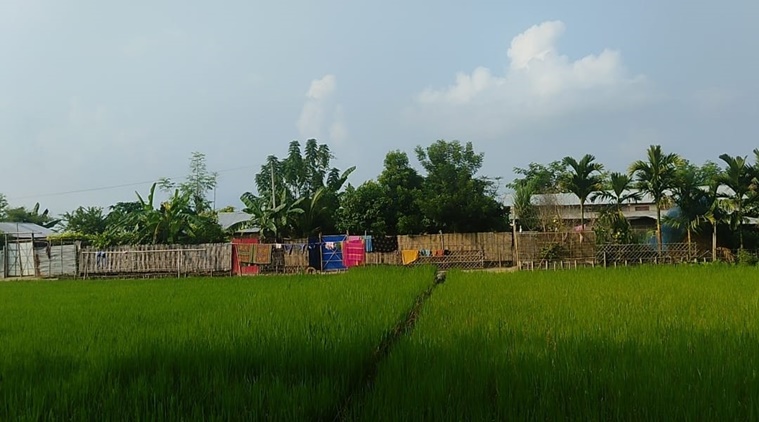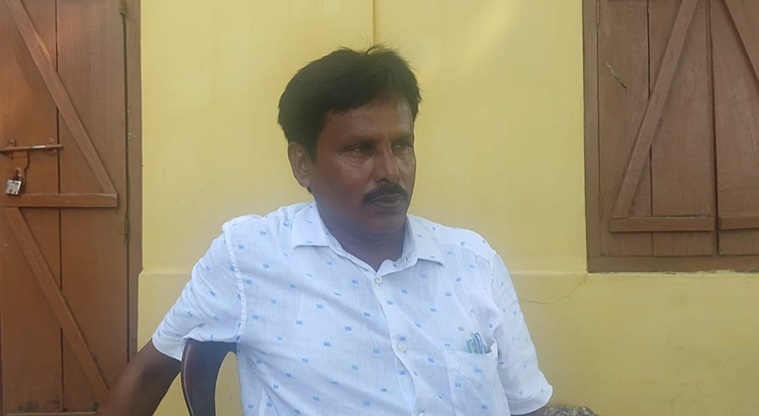[ad_1]
School-going children and the elderly made up most of the audience gathered under the pink and green shamiana (marquee) pitched in the market in the small town of Kaki in Assam last week.
As two young men moved among the audience depositing black gram in their cupped hands as the afternoon’s refreshments, local leader Monwar Hussain spoke into a mic, “There are not many people who are not aware of the law against child marriage… As a society, everyone should be working on their own homes. Parents, don’t give your young daughters in marriage. Our little sisters, if you hear of a friend or classmate about to get forcefully married off, tell your teacher or quietly call 1098. If everybody and all students work together, we should be able to aim to end child marriage by 2026.”
This public meeting, organised by the All Assam Minority Students’ Union (AAMSU) in an area where the population largely comprises Bengali-origin Muslims, was being held a week after 31 people from the district — Hojai — were arrested overnight in a police crackdown against child marriage. Thirteen of those arrested were men who had married underage girls and 18 were relatives booked for facilitating these marriages.
Tackling a difficult conversation
However, this was not the first wave of arrests related to child marriages in the area. Eight months ago, in February, a whopping 219 people were arrested from the district over the course of a few days in an unprecedented punitive crackdown against child marriage in the state.
Between these two rounds of arrests, while the state administration held some awareness meetings and appointed Gaon Panchayat secretaries as village-level Child Marriage Prohibition Officers (CMPOs), the hard work of tackling conversations on the subject and working against the practice has largely been shouldered by people within the community in the area.

 At Ashinagar, a village in Hojai district, the topic of child marriage prevention is broached each time meetings are held by block-level officials in the village. (Express Photo)
At Ashinagar, a village in Hojai district, the topic of child marriage prevention is broached each time meetings are held by block-level officials in the village. (Express Photo)
At Islam Nagar, a village in Hojai district, Gaon Panchayat Secretary Shahabuddin said he had attended a meeting at the District Collector’s office a few months ago with other such secretaries. At the meeting, he said, they had been told that as CMPOs, they should check age certificates to issue no-objection certificates for marriages in their respective villages.
However, beyond attending that meeting, it is evident that nothing much has been implemented through this new role in the village. Shahabuddin says that no marriages have taken place in the village since then. Since no written order or notification was issued regarding the new responsibilities or duties, he said the Gaon Panchayat too has not taken any steps towards building awareness.
At Ashinagar, a village in the same district, Gaon Panchayat members said an awareness meeting had been held by block-level officials earlier this year. They said the topic of child marriage prevention is broached each time meetings are held by department on issues like public health or education in the village. But Gaon Panchayat members claimed they were not aware of any arrests in the village as part of the crackdown.
A dilemma and a decision
On the other hand, a designated ASHA worker for a village in the district said she knew of a family nearby who had a case of child marriage registered against them but “the husband escaped before the police arrived”.
The ASHA worker also knew that an underage girl married into the village had given birth at her maternal village 15 days ago, after which the police arrested members of the family.
At the village level, the ASHA worker is the person working most consistently to spread the message against child marriage and as a grassroots health worker, she also has her ears closest to the ground.
Before the February crackdown, the ASHA worker had attended a training session at a local hospital. Apart from spreading awareness against child marriage, ASHA workers were also instructed to make a significant change in the manner in which they collected data.
“Earlier, while maintaining our records on pregnant women, we would just ask their age and write whatever they told us. Now, we have been told to check their Aadhaar cards and write down their date of birth instead,” she said.
 Shahabuddin at the gram panchayat office in Islam Nagar, a village in Hojai district. (Express Photo)
Shahabuddin at the gram panchayat office in Islam Nagar, a village in Hojai district. (Express Photo)
The ASHA worker added, “Whatever I am doing for the day — whether I’m conducting a vaccination session or going from house to house checking on pregnant women — I always discourage families from marrying off girls who are too young.”
But this advocacy, she says, has resulted in suspicion and wariness from the village community towards her. Thanks to the crackdown on child marriages, the community assumes that she will use the information she collects on the job to point the police in their direction.
“Not just me, even other ASHA workers operating nearby have mentioned instances of being shooed away when we go for home visits. Many people are reluctant to come to us now,” she said.
So the ASHA worker has chosen to draw limits for herself. She spoke about a family from the village that went away for a few days and came back with a bride from a nearby district. When she heard about it and went to check, she discovered that the bride was underage. The ASHA worker said she told the family to take the girl back to her home, which they did for a while, but they brought her back again and she later got pregnant.
“I only found out (that she was back) after she was already pregnant. Technically, I’m supposed to report this to the authorities so that action can be taken against the family, but I made the call not to. Ultimately, I live in the village and have to live in this society. I can’t have them become hostile towards me. She is already pregnant and there was nothing to be done. I’d rather focus on stopping matters before they get to that stage,” she said.
According to the National Family Health Survey (NFHS-5) 2019-2020, 31.8 per cent of women in Assam aged between 20 and 24 years were married before the age of 18. In Hojai district, the number was 30.9 per cent. In the case of women aged between 15 and 19 years who were already mothers or pregnant at the time of the survey, the figure for Assam was 11.7 per cent. For Hojai, it was 15.6 per cent.
A punitive crackdown and a reformative campaign
In that, the ASHA worker is largely on the same page as activists of the AAMSU — which has members in every village and has been carrying out a movement against child marriage since 2017. While Assam government’s punitive anti-child marriage drive has largely been viewed as affecting the state’s Bengali Muslim community, the minority union’s campaigning has been a reformative one — to address the issue from within the community. So they have been holding frequent meetings, like the one held in Kaki last week, specifically underlining education — girls’ education in particular — as the ultimate solution. But they also claim to have intervened and stopped several child marriages from taking place.
Fakhrulin Islam, an AAMSU activist from Islam Nagar village, says he personally intervened and stopped two marriages: one in 2019, and the other, that of a Class 9 student, last December.
Most Read
“This is a matter we want to address within the community. So we try to convince families by speaking to them and counselling them. The last resort is to call the administration and the police, if all other means fail… When we first started this campaign, there was so much resentment against us. One good thing that came out of the government’s drive is that many people were thankful to us and told us that if we hadn’t intervened, they would have been in jail,” he laughed.
A provincial school in the district too has been advocating against child marriage in its own way over the past few years. Badrul Islam Beg, the principal of Doboka Higher Secondary School, said the school has been talking about child marriages during parent-teacher meetings, and health and hygiene workshops. However, he said, all efforts have been disparate and disorganised due to lack of institutional intervention.
He added, “Ideally, there should be intervention by the (education) department so that campaigns at the grassroots level can be organised at the school level on the lines of those conducted by anti-tobacco and eco-clubs. The arrests are preventing child marriages because of fear, not awareness. At the end of the day, without awareness, young girls will still be seen as a burden by their families.”
[ad_2]
Source link






